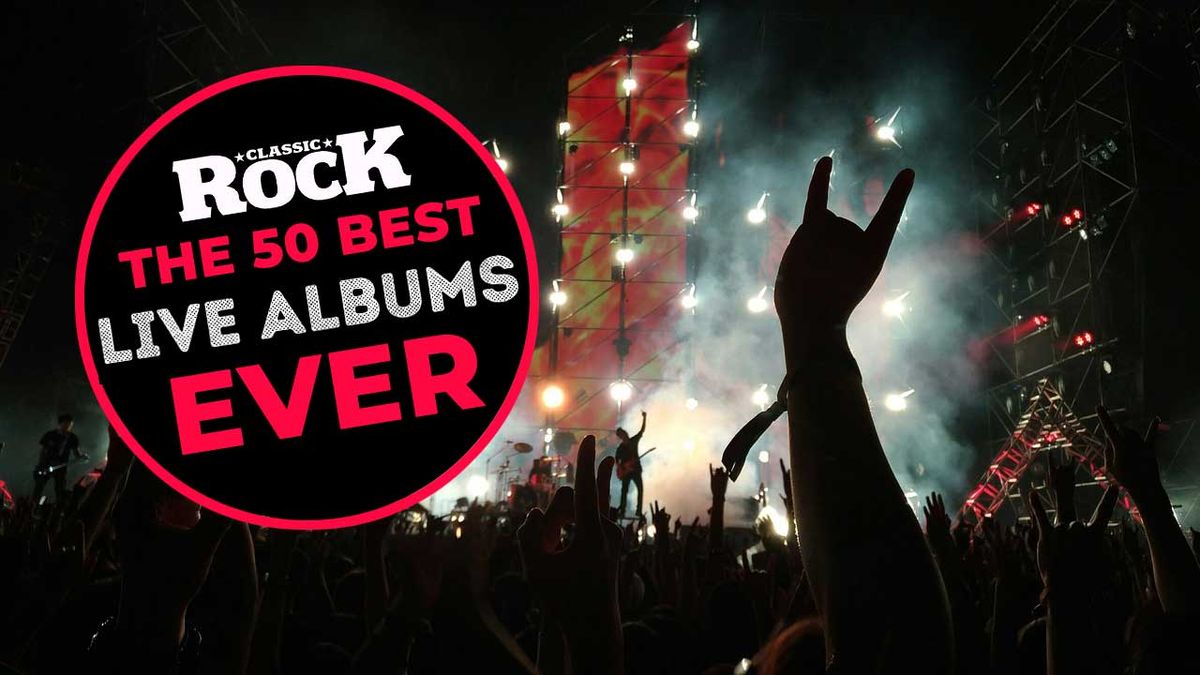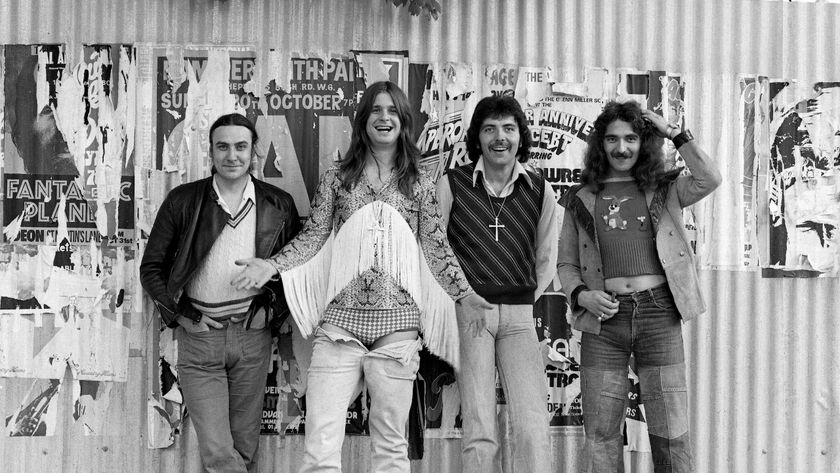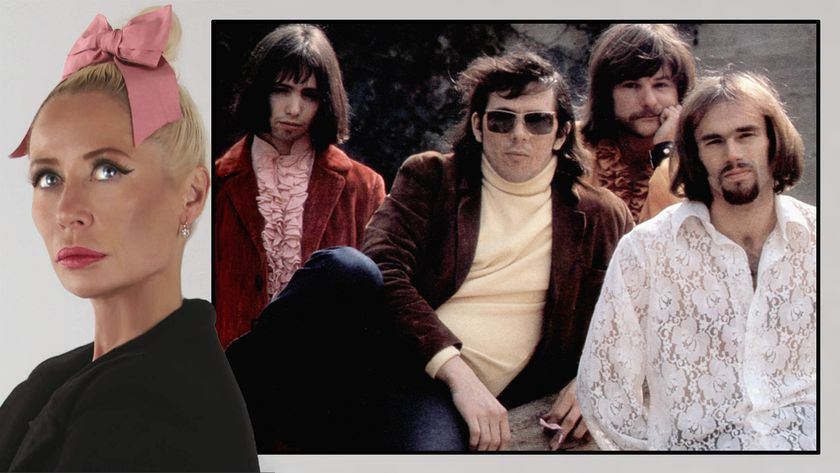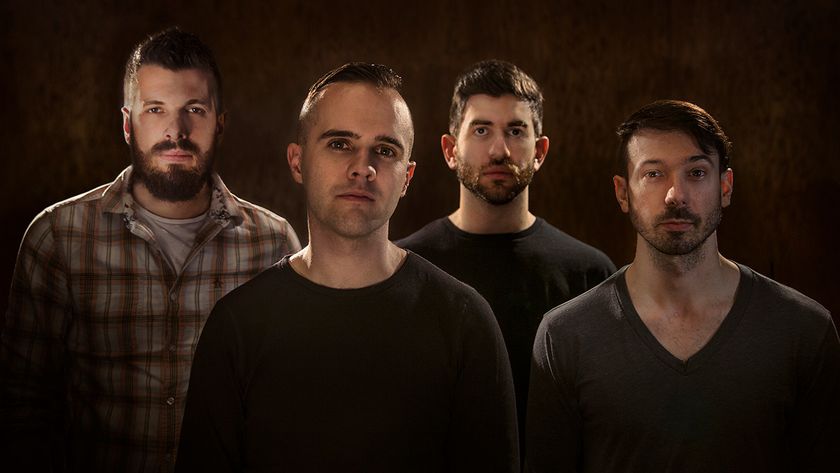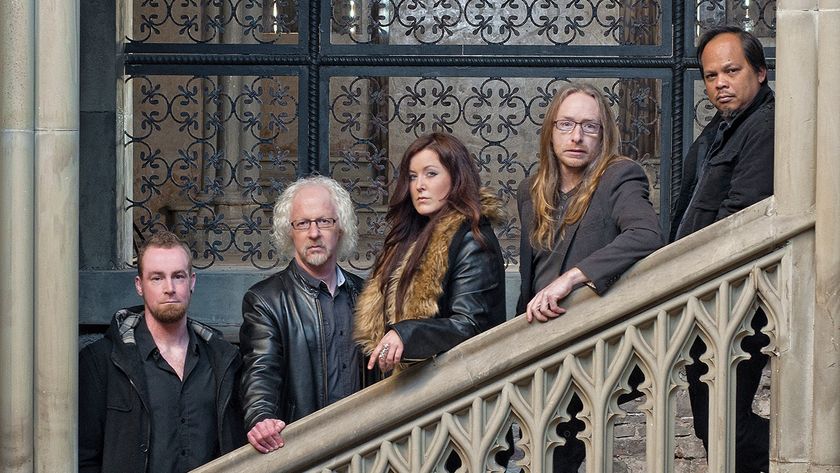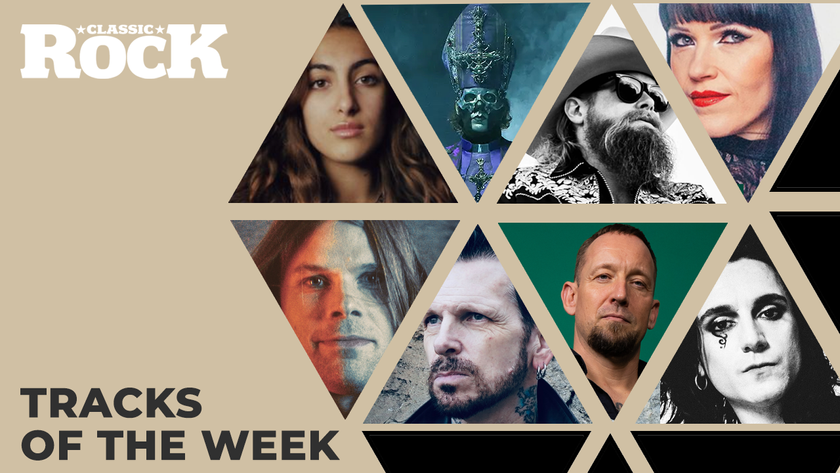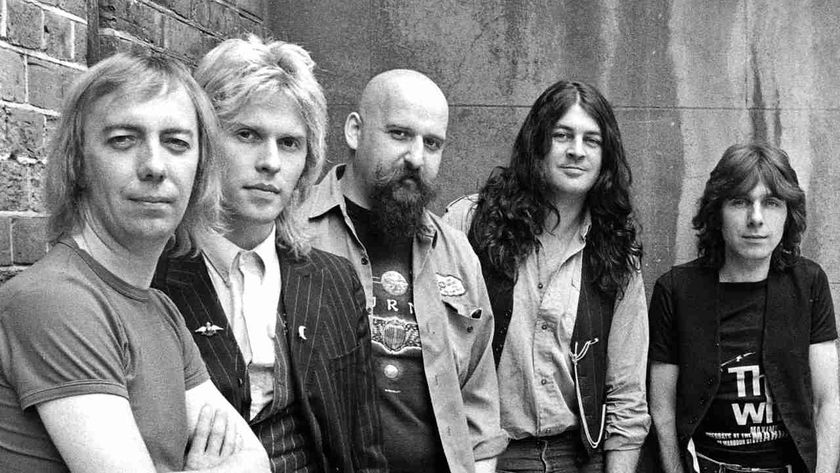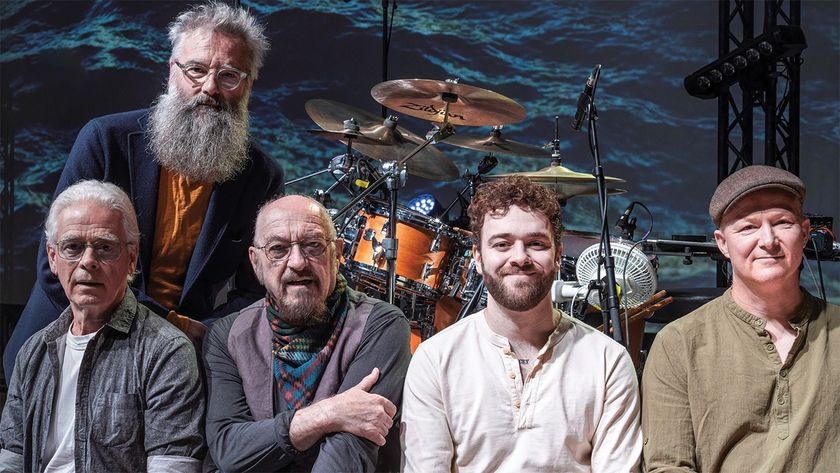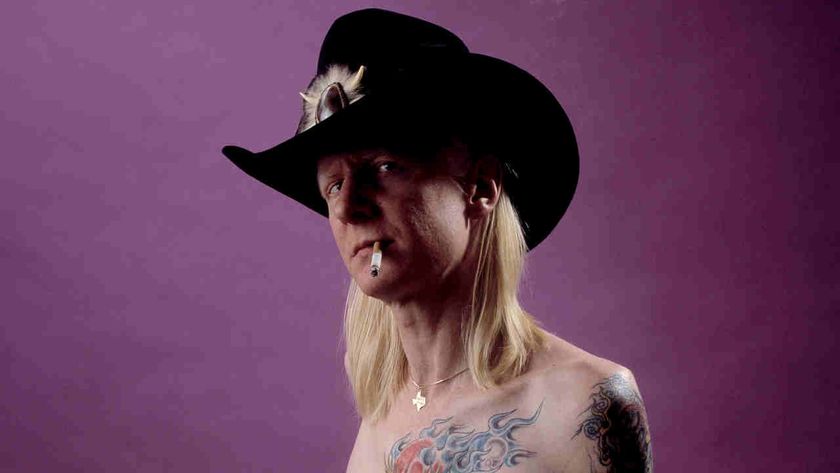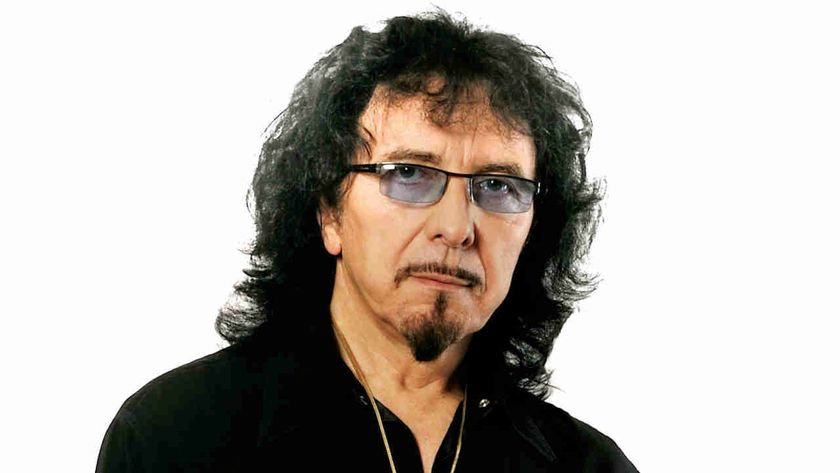Nothing beats seeing your favourite band live, but one thing comes close: a recording of that band at their peak, playing their best songs – with the added energy that comes from live performance and an eager audience – on a recording that captures both.
So many great live albums have been made over the years, especially in the ‘70s and ‘80s. And in the world of hard rock and heavy metal, the live album has become an art form in itself.
For some bands, such as Kiss, Cheap Trick and Bob Seger, it was a live album that provided them with their big breakthrough. And for one artist in particular, Peter Frampton, a live album would be theit breakthrough, their biggest seller and largely define their career.
With the greatest live albums it’s really all about timing. What they represent is a defining moment in a band’s career: for many, a coming of age as a truly great band. And that's as much a part of the magic as the music, the performance, and the atmosphere generated between band and audience in the heat of the moment. Or in the Heart Of The City, as David Coverdale might say.
So here they are: The 50 best live albums ever.

50. Ramones - It's Alive
The ultimate live punk album? We can’t think of many to top it. With barely a breath drawn by the band between songs, this is the sound of London’s Rainbow Theatre – so often the setting of cosy all-star jams – being battered into submission by the world’s fastest setlist. That's 28 songs in an hour, folks.
It really doesn’t get any better than Blitzkrieg Bop. Hell, bassist Dee Dee Ramone’s cry of “1-2-3-4” is anthemic in itself, but the ‘Hey Ho! Let’s Go!’ chant (apparently inspired by the Bay City Rollers) is, like all classic Ramones, a work of simplistic genius.
Three decades later, and the sweat still doesn’t smell stale.
49. Various: Woodstock: Music From the Original Soundtrack and More
In 2019 the 50th anniversary of the original Woodstock festival was celebrated with the release of an expanded, 38-CD, 432-track box set version of the original soundtrack, featuring 267 previously unreleased tracks.
It was possibly overkill, but the very fact that it was released at all pays testament to the initial release's longstanding cultural significance. If live albums are about capturing a moment in time, Woodstock: Music From the Original Soundtrack and More succeeded brilliantly, from the "brown acid" stage announcements to Jimi Hendrix's charged version of the Star Spangled Banner.
The rest of the cast is similarly stellar: The Who, Joe Cocker, Crosby, Stills, Nash & Young, Santana, Jefferson Airplane, Canned Heat, Sly & The Family Stone and more, and a performance from Ten Years After that would come to define their entire career. And that couple on the cover? They're still together.
48. Grand Funk Railroad – Live Album
Just as the band who made it gave new meaning to the description ‘power-trio’, so Live Album set the template for everything we now know as stoner rock. Sold as a ‘direct recording’ – ie no overdubs, no remixing, no nothing except slabs of sheet-metal – it was all about keeping it real (pity nobody thought to tell the sleeve-designer who used a photo of the band taken at the Atlanta International pop festival, even though none of the music was recorded there).
Even the most fervent Grand Funk Railroad fan from the 70s would have agreed that you really didn’t need to possess more than one of their two-inch deep studio albums, and you certainly didn’t dig the Funk lying on the floor listening to those records with your stereo-headphones on. You dug them where they lived, out on the road. Hence the tremendous sense of righteousness that accompanied the release of this, their fourth album.
Critics dismissed them as boneheaded proto-metal merchants, but in singer-guitarist Mark Farner – a fierce part-Cherokee frontman who took no shit and gave no quarter – Grand Funk Railroad became the embodiment of what it meant to be an all-American rocker, and the success of Live Album refutation that what critics said mattered at all.
47. Hawkwind – Space Ritual
If a live album is supposed to sum up a band’s career to that date, then this one more than does the job for Hawkwind. Recorded in Liverpool and Newcastle in 1972 on the Doremi Fasol Latido tour, the presence of electronic and spoken-word interludes linking the music together adds to the atmosphere.
"I read about them in one of my dad’s Penthouse magazines," says former Dead Kennedys frontman Jello Biafra. "I checked out In Search Of Space, but I didn’t like it. Then I got Space Ritual and it blew me away. I not only liked its power but its ethereal hypnosis too. This, and an increase in weed consumption, was a gateway to the more powerful side of psychedelic music and eventually prog rock."
"What bands tended to do was clean the sound up to make it as much like a studio album as possible," author Ian Rankin told us. "Space Ritual was different. It was an grungy live sound, with lots of opportunities for things to go wrong. It was the first that made me feel like I was there, a propulsive, hypnotic show with all these wonderful bleeps, blips and droning guitars that were almost transcendental."
46. Aerosmith - Live! Bootleg
On July 4, American Independence Day, Aerosmith top-billed at the Texxas World Music Festival at the 100,000-capacity Dallas Cottonbowl, with Ted Nugent and Heart as support acts, along with Journey and Eddie Money.
They also played a few low-key club shows, billed as Dr. J. Jones And The Interns, which were recorded by Jack Douglas for the live album that was released on October 27. They named it Live! Bootleg, and the titled implied, it was, by design, the antithesis of Peter Frampton’s sweet-sounding mega-hit Frampton Comes Alive!
"I love that record," Slash tells us. "That to me is the quintessential live rock’n’roll album of all time. It’s amazing. The way that Live! Bootleg starts with Back In The Saddle, that whole intro with the crowd going crazy and the flash-pots going off, that whole build-up, made it so exciting to me."
"The great thing about live records at the time was if you didn’t have any other records by the band, you could get a good cross section of their material all on one album," says broadcaster Eddie Trunk. "I remember getting Live! Bootleg, putting the poster up on my wall, and to this day, I think it is an unbelievably underrated live record. And it is actually a true live record. It just reeks of the ‘70s - it really puts you into the space of when the songs were recorded."
45. Alice In Chains - Unplugged
Alice in Chains Unplugged marked the second to last performance from singer Layne Staley, who was battling the crippling addiction to heroin he'd poignantly chronicled through the band's agonising lyrics.
This performance is a chilling portrait of the tragic downfall of one of rock's most charismatic and enigmatic frontmen, from glam rock loving metal star to bedraggled junkie.
But AIC's down-tuned sludgy heavy metal somehow lends itself to the acoustic format. Every song transforms from powerful, angry catharsis to haunting lament. And these small but poignant shifts add a tragic and heart-wrenching depth to the entire album.
44. Jethro Tull – Bursting Out
In April ’78, just after the release of Heavy Horses, Jethro Tull toured the UK and Europe. The resulting Bursting Out, released in October, was a live double album that showed the band in great shape, with a tracklist that runs the full Tull gamut - from folk whimsy to rock crunch – and provided a decent overview of the band's career.
"Make no mistake: in terms of sheer professionalism, Jethro Tull are without peer," wrote the infamous Lester Bangs, perhaps the last journalist you'd expect to fall for the charms of a Lancastrian folk-rock group led by a wild-eyed flautist.
"They stand out by never failing to deliver a full-scale show," he continued, "complete with everything they know any kid would gladly pay his money to see: music, volume, costumes, theatrics, flashy solos, long sets, two encores. Jethro Tull are slick and disciplined; they work hard and they deliver."
43. Scorpions - World Wide Live
While 1978's Tokyo Tapes might be the hardcore fans' favourite, 1985's World Wide Live captures Scorpions at their commercial peak, with the occasional flower-powered excursions of the Uli Jon Roth era consigned to rock's great dustbin. Instead, the performances were relentlessly taut and ruthlessly delivered.
"Every performance here is a killer," guitarist Rudolf Schenker told us. "It was recorded at so many cities across the world, and our producer Dieter Dierks came on the road with us and spent ages going through every recording we made to find the best version of each song.
"It was a long job, but worth it. This represented how exciting everything was for us at the time, because we were headlining massive venues."
42. Humble Pie – Performance Rockin’ The Fillmore
They were impressive enough in the studio, but playing live was where Humble Pie really excelled. This sprawling double album, recorded in New York in May 1971, is a magnificent showcase for Marriott’s searing vocals and his fierce interplay with fellow guitarist Peter Frampton.
Apart from the rampaging might of Stone Cold Fever, the songs are spirited covers, from the slow jam of I’m Ready to extended versions of Rolling Stone and the R&B classic I Don’t Need No Doctor. Perhaps the pick of the bunch is a titanic reconfiguration of Dr. John’s I Walk On Gilded Splinters, stretched out dramatically over a wholly compelling 24 minutes.
41. Jimi Hendrix - Band of Gypsys
For a record delivered as a contractual get-out, Band Of Gypsys is some live album. With a new rhythm section after the break-up of the Experience, Jimi Hendrix headed off in different directions to explore the new musical territories of funk and R&B, and did so with a new-found precision and regenerated energy and creativity. His playing here is, in places, truly wonderful and masterfully controlled.
Hendrix was on the brink of new horizons, and Band Of Gypsys was, as he might have said, “a first step” at not only reshaping his direction but that of rock performances. The spontaneous improvised spirit was definitely picked up in the 70s by the Allman Brothers Band, Led Zeppelin and the Grateful Dead, among others.
"It’s not a perfect recording," Joe Satriani told us, "but I’m listening for the heart and soul. He changed the course of music in one evening. If it only contained that version of Machine Gun, that would be enough for me. That’s the Bible, the grimoire of electric guitar."
40. Little Feat - Waiting for Columbus
Many hardcore Little Feats would argue that Waiting for Columbus isn't Little Feat's best live album – that honour going to the widely-bootlegged radio broadcast Electrif Lycanthrope – but it's still a stunning collection.
Recorded in London and Washington DC, it showcases the band at their effortlessly slick best, with a sound padded out by the Tower Of Power Horns. It's somehow laid back and filled with energy at the same time, and while the band may have been in decline as far as their recorded work goes – they were two years past their absolute peak when Waiting for Columbus was recorded – the album still outshines their studio work from the same period.
It's so good that when the band released an expanded edition in 2002, it contained at least three tracks – Skin It Back, One Love Stand, Rock and Roll Doctor and On Your Way Down – that weren't just as good as anything on the original, but were better than most band's best live recordings. Stunning stuff.
39. Kiss – Alive II
Kiss made their big breakthrough with Alive! Two years later came the sequel, and it was another blockbuster. Recorded on the Love Gun tour, Alive II reached No.7 on the US chart, two places higher than Alive! It was also a better representation of the Kiss live experience.
There are many great moments on Alive II: the pure adrenalin in Love Gun; all the girls in the audience screaming as drummer Peter Criss sings the hit ballad Beth; guitarist Ace Frehley sounding shitfaced on his signature song Shock Me. There is also a killer Ace song, Rocket Ride, among five additional studio tracks that were on side four of the original vinyl version.
The band sounded more powerful on tracks such as I Stole Your Love, Shout It Out Loud and Makin’ Love. The audiences were more hysterical. And the original vinyl-issue gatefold cover opened to reveal the full OTT splendour of Kiss on stage.
Slipknot's Mick Taylor agrees: "It’s not necessarily the greatest but the artwork on Alive II with Gene’s sweat running, the blood coming from his face and the make-up running had a profound influence on me. You only have to look at my own band to see how much so."
38. Whitesnake – Live… In The Heart Of The City
Long before David Coverdale set the controls for the heart of America, he created Whitesnake as a blues-based hard rock band in the classic tradition – and this live album was their greatest moment.
Released in November 1980 as a double-disc set, Live… In The Heart Of The City was in effect two albums in one: the first disc recorded in June 1980; the second cut two years earlier. In both cases, the venue was the same: London’s Hammersmith Odeon. But by 1980, the band had its definitive line-up: Coverdale on vocals, Bernie Marsden and Micky Moody on guitars, Jon Lord on keyboards, Neil Murray on bass and Ian Paice on drums.
It’s what Manic Street Preachers bassist Nicky Wire likes to call “proper Whitesnake”. There is a deeply soulful quality to the band’s version of Ain’t No Love In The Heart Of The City, the R&B song made famous by Bobby ‘Blue’ Bland, its chorus taken up with gusto by the fans – ‘The Whitesnake Choir’, as Coverdale called them.
Equally, there is pure hard rock power in tracks like Come On, Love Hunter and Walking In The Shadow Of The Blues. And best of all is the hit single Fool For Your Loving, introduced by Cov in immortal faux-Cockney style: “’Ere’s a song for ya!”
37. Ted Nugent - Double Live Gonzo!
“Live is special," Ted Nugent told Classic Rock's Geoff Barton in 1976. "Epic [Nugent's label] wants us to do a live album in fact, but I don’t really think that the time is ripe. I want to approach it special – I think live is special. If we’re going to do a live album, I really want to be live. I want to be able to scream ‘MOTHERFUCKERS!’ on the tape."
Two years later the Nuge was as good as his word, delivering Double Live Gonzo!, and it went triple platinum. While it's difficult to imagine everyone's favourite reactionary killing and grilling guitar hero doing such brisk business today, it's worth taking to a moment to remember that at one time, Nugent was a genuine hot property.
Double Live Gonzo! shows why. Nugent goes crazy, his band toughen out the sound, there’s a sense of self-indulgence that actually works to the album's advantage. There are also truly some stunning moments, including Nugent rapping like a mad-eyed Del Boy, and a rendition of Great White Buffalo that is quite magnificent.
36. Led Zeppelin – How The West Was Won
There can’t be any doubt that Led Zeppelin were the hottest rock group on the planet when they pummelled the Forum in Los Angeles on June 25, 1972 and destroyed Long Beach Arena two days later.
Jimmy Page considered the band were at the height of their powers at the time, following the monumental 1V. It wasn’t a question of how the West was won – America had already fallen – more why they didn’t prove it at the time by releasing a live album.
That oversight was rectified in 2003 with the release of the three-CD How The West Was Won. Of course it’s familiar. The snatch of LA Drone is followed by the three-minute warning of Robert Plant’s Valhalla screech in Immigrant Song, and Page showing off his full range, from madrigal to power chord crunch, on Heartbreaker. It’s what it is.
Black Dog’s lascivious blues leer sounds a tad embarrassing at this juncture (it’s noticeable that Plant shows no interest at all in his own ancient history), but we can’t rewrite his past. Better to bask in the breaks as Over The Hills And Far Away transitions from British folk into the furiosity of John Bonham’s impersonation of someone detonating a device inside an iron and steel foundry.
35. U2 – Under A Blood Red Sky
Pieced together from stop-offs on 1983’s War tour – including their game-changing set at Red Rocks – Under A Blood Red Sky was a shot in the arm for the live album format as its golden age began to dip. Its release felt like a pivotal moment; the live album was still the calling card of the rock behemoths, and not to be meddled with by rag-tag members of the post-punk underclass.
But U2 had grown up eyeing the bands behind the great ones – Bono has cited the impact of Thin Lizzy’s Live And Dangerous – and here they hijacked the format on such sky-scraping moments as I Will Follow and The Electric Co. (the latter costing them $50,000 after Bono dropped in an unauthorised snippet of Stephen Sondheim’s Send In The Clowns).
It worked, too: Under A Blood Red Sky enjoyed monster sales, woke up America and reignited the live album as a commercial proposition. The future would hold giant lemons, Salman Rushdie cameos and the sheer ubiquity of Bono, but this album is the sound of a flesh-and-blood live band who didn’t need gimmicks to own a stadium. Remember them this way.
34. Talking Heads - Stop Making Sense
More famous for the concert film than for the soundtrack itself, Stop Making Sense finds Talking Heads in 1983 – at the height of their popularity – as they tour Speaking In Tongues. This film is the stuff of legend now, from its artful staging to its constant frenetic energy, intricate dance moves and – of course – that massive suit.
“We didn’t want the cliches," said Chris Frantz. "We didn’t want close-ups of people’s fingers while they’re doing a guitar solo,” he says. “We wanted the camera to linger, so you could get to know the musicians a little bit.
“The idea was to have the movie presented to the viewer as if the viewer had the best seat in the house – and that doesn’t involve looking at the audience. We thought it would be like seeing the concert the way we in the band would like to see it.”
33. Wings - Wings Over America
“It was a very exciting time and the Wings Over America tour was the culmination of a lot of hard work," Paul McCartney told us. "When I think back to that era it was very happy. We’d come up the hard way. Now, finally we were in the US in 1976 and it was all coming round. We needed to see if we could make it at a bigger level – and America was that bigger level. It was the place to crack.”
That sense of freedom, excitement and discovery is captured perfectly on the triple-vinyl live set that emerged from the tour. The highlight is probably Maybe I’m Amazed, a stately delivery of the standout track from 1970's McCartney debut solo album. Vocally, Macca rings every inch of emotion out of the pleading lyric and Jimmy McCullough wades in with a quite majestic solo.
Strangely, the track listing – heavy on the band's June show at the Forum in Los Angeles – was partly a reaction to the success of an earlier triple-vinyl bootleg release, Wings from the Wings, which provided the focus group to Wings Over America's finished product.
32. Rainbow – On Stage
In the 70s, the double live album was a defining statement for such giants of rock as Kiss, Lynyrd Skynyrd and Thin Lizzy. Blackmore cut two monolithic live doubles with Deep Purple, and Rainbow’s On Stage he matched them for bravura and excess.
Recorded on the Rising tour, it featured the definitive line-up of Blackmore, Dio, Powell, bassist Jimmy Bain and keyboard player Tony Carey. Across four sides of vinyl were just six tracks, including a marathon version of Purple’s heavy blues Mistreated. And while Dio soared, it was Blackmore’s virtuosity that shone brightest.
31. The Band - The Last Waltz
Recorded on Thanksgiving Day in 1976, The Band’s eloquent command of sources is underlined by the appearance of Muddy Waters for the emphatic Mannish Boy, Mavis and The Staple Singers taking The Weight all the way to the Baptismal font, and their first employer Ronnie Hawkins invoking Bo Diddley voodoo.
This is a heart-lifting celebration of a vanished era, Bob Dylan back with his barnstorming Basement Tapes buddies, Joni Mitchell at her luminous peak, Neil Young and Dr John in Night Tripper mode. The one sore thumb in the whole gathering remains Neil Diamond, included against the better judgement of his colleagues by Robbie Robertson, who had coincidentally produced a recent album.
But one Diamond does not a dog’s dinner make, and The Last Waltz captures an extraordinary musical community at the point of dispersal and preserves it for the ages.
30. Nirvana - MTV Unplugged in New York
Wary of the Unplugged format, Nirvana agreed to record this on the condition that their performance skipped the hits to explore their catalogue’s dark corners and rifle through Kurt Cobain’s record collection. Even then, Dave Grohl recalls, two days of rehearsals were “horrible”, the band struggling with acoustic instruments, the singer suffering from heroin withdrawal, the drummer hitting too hard. “That show was supposed to be a disaster,” Grohl concludes.
Against the omens, when Nirvana took the stage on November 18, 1993 it all clicked, right from the moment that Bleach’s lumpy About A Girl revealed itself as a tinglingly pretty pop gem. Highlights include the squeezebox-bolstered Jesus Doesn’t Want Me For A Sunbeam and the magical All Apologies, but the best comes last, when Cobain’s drawl breaks into a ravaged howl at the three-minute mark of Where Did You Sleep Last Night.
In retrospect it’s easy to read the signs that Cobain was not long for this world, from the funereal stage vibe to the icy cover of David Bowie’s already bleak The Man Who Sold The World. And five months later he was gone, making a transatlantic No.1 inevitable when the album was released posthumously. Unplugged or not, it’s electrifying.
29. The Rolling Stones – Get Yer Ya-Ya’s Out!
Recorded at New York’s Madison Square Garden on the band’s 1969 US tour – their first since the appointment of Mick Taylor as replacement for original guitarist Brian Jones – the impulse behind the Rolling Stones’ second live LP was less documentary, more simply a gauge of how well the new line-up was settling in. But the result was one of the first live albums to receive the kind of acclaim only the best studio albums had before, thereby kick-starting a taste for live albums that would flourish throughout the subsequent decade.
The sheer exuberance of the Stones’ performances on that tour – which also featured openers BB King, Chuck Berry and Ike & Tina Turner – is clearly captured in the grooves. It was also the first Stones tour since the death of Keith Richards’ original co-guitarist Brian Jones, whose increasingly drugged and emaciated state had effectively kept the band off the road for nearly three years.
In his place stepped Taylor, a 20-year-old former John Mayall protégé whose extravagant gifts as a guitarist were first recognised internationally with the release of …Ya-Yas. He’d played on Honky Tonk Women and a couple of tracks on Let It Bleed, but this album and the tour it was recorded on gave notice of a new creative phase for the Stones that would see them record the best studio albums of their career.
28. Genesis – Seconds Out
"I love Paris in the springtime!” says an animated Phil Collins during Seconds Out, the live double album released by Genesis in October 1977. Recorded mostly over four nights at the Palais des Sports in June – technically not spring, but let’s not spoil the moment – the record documented the band’s Wind & Wuthering tour (though it includes only Afterglow from that then-too-recent-to-fillet album).
With Collins comfortably ensconced as frontman/vocalist and Chester Thompson drumming, the music hit the sweet spot between the group’s old and new identities, as they showcased a blend of their classic prog – Supper’s Ready, Firth Of Fifth and The Cinema Show (the last was actually taken from a 1976 show with Bill Bruford in the drumstool) – and more focused favourites from the dawning of ‘the Phil era’, with A Trick Of The Tail generously represented.
While Genesis didn’t consider live albums to be massively important, to one generation of fans this offering was the way in, a first introduction to their catalogue. As such, there are some of us who still think of these versions as the definitive ones.
27. Neil Young & Crazy Horse – Live Rust
Recorded on the tour to support Rust Never Sleeps (confusingly, a live album later overdubbed in the studio), Live Rust finds Crazy Horse at their fieriest. It takes a while to arrive, though: the first half of the album is Neil Young at his folksiest, gently taking the audience through his career, from Sugar Mountain – written for his teenage band The Squires – through Buffalo Springfield and finally on to My, Hey (Out Of The Blue).
It's lovely stuff, but the pace and volume are upped during the second half as the band arrive and the songs begin to sprawl, Young pulling in all different directions as the band remain resolutely in-pocket. What you get with Live Rust is the best of both Neil Youngs: the troubadour and the troublemaker.
It also concludes with the finest versions of Like a Hurricane, Hey Hey, My My (Into the Black) and Tonight's the Night in the entire Young catalogue.
26. Johnny Cash - At Folsom Prison
The real jailhouse rock. Johnny Cash had been performing in prisons for 10 years, but this 1968 show captured him at his rawest, singing of crime, troubled conscience and life behind bars. His connection with the inmates is electric, especially on rap-sheet rockers Cocaine Blues, 25 Minutes To Go (Cash’s unhinged vocal foreshadows punk) and Dark As A Dungeon.
It’s a total communion, artist and audience living the songs together. To break the intensity, Cash interjects funny asides such as: “This is being recorded for an album, so I can’t say ‘hell’ or ‘shit’ or anything like that."
"I've always idolised 'The Man In Black'," masked alt.country star Orville Peck told us. "This was the first Johnny Cash album I had ever listened to when I was a kid. But it wouldn't be until I was much older that I would fully appreciate the groundbreaking elements of this incredible live album."
25. Judas Priest – Unleashed In The East
One of the greatest live metal albums ever made, Unleashed In The East was overdubbed (Rob Halford has admitted that he was suffering from flu when these shows took place, and this ruined his vocals) to the extent that it was jokingly rechristened Unleashed In The Studio, yet it’s powerful and atmospheric.
Recorded in Tokyo, the album includes definitive versions of landmark tracks Victim Of Changes, The Ripper, Sinner and Exciter, plus a masterful interpretations of the early Fleetwood Mac’s darkest song, The Green Manalishi (With The Two Pronged Crown).
This was the first Priest album to make the UK Top 10 – peaking at number 10 – and the US Top 100, making it to number 70.
24. Bruce Springsteen & the E Street Band - Live/1975-85
For an artist whose reputation was sealed by the burning intensity of his live shows, it was a surprise Bruce Springsteen waited so long before putting out a live album. By the time he did, he was already playing stadiums, and Live/1975-85 was the motherlode: ten years of recordings spread across five discs, going back as far as 1975's tour promoting Born To Run.
It was almost like it was too much to consume. For years following its release you could find unwanted, unloved copies of the box in second hand stores, and only since the vinyl revival has its value climbed to the kind of amounts you'd expect.
With good reason. Live/1975-85 is testament to both the E-Street Band's unrivalled power as a live unit, and to Springsteen's untouchable command of a live audience. Just listen to Springsteen's heartfelt introduction to The River, or the acoustic mini-set given over to songs from Nebraska, or the climactic, life-affirming Born To Run. In the absence of a three-and-a-half hour show from the Boss, this is a pretty decent substitute.
23. Motörhead – No Sleep ’Til Hammersmith
Everything louder than everything else was their motto, and that’s how it sounded on No Sleep ’Til Hammersmith. It featured the definitive Motorhead line-up: Lemmy on bass and vocals, ‘Fast’ Eddie Clarke on guitar, ‘Philthy Animal’ Taylor on drums. And they were riding high off three back-to-back classic albums: Overkill, Bomber and Ace Of Spades.
There is a manic intensity in their speed-driven attack, and a general sense of on-the-road lunacy summed up when a roadie introduces the track (We Are) The Road Crew by screaming into the mic. Ditto the album’s title: the battle cry for a campaign of ransacking and pillage.
22. Rory Gallagher – Irish Tour ’74
Irish Tour ’74, a two-million selling vinyl double, has long been thought his best – a masterclass in improvisational blues rock with breathtaking guitar solos. In effect it was three-sides a soundtrack to a Tony Palmer film of the tour, plus one side of after-hours jamming recorded on the Ronnie Lane Mobile Unit.
While the sound quality is variable – partly due to the fact that they couldn’t get insurance for Ronnie Lane’s Mobile Studios in the more troubled areas of Northern Ireland – the album never loses its primal, raw urgency. It’s the sound of a band leaning out over the precipice – something Rory Gallagher deliberately encouraged, making up the show as he went along.
21. Queen – Live Killers
By the end of the 1970s, Queen had become a true-blood mainstream band – the sort who regularly enjoyed a huge chart impact. So it wouldn’t have been a surprise to anyone if their live shows were starting to suffer. But they didn’t.
Recorded earlier in 1979, the double Live Killers album was all the proof anyone could need that Queen were one of the best live bands in the world, and they could teach anyone a few tricks.
We Will Rock You opens up, and this metallic, bombastic and ferocious delivery just stuns. The inspired medley of Death On Two Legs, Killer Queen, Bicycle Race and I’m In Love With My Car works so well you’d swear this was the way the songs were created.
There are few better live albums than Live Killers, and the absence of the visual impact only serves to heighten the band’s sheer musical audacity and verve.
20. Bob Seger & the Silver Bullet Band - Live Bullet
Recorded at the 12,000-seat Cobo Hall in Detroit at a time when Bob Seger was struggling to fill club venues in other towns, ‘Live’ Bullet brings together tracks from 1975’s Beautiful Loser with a smattering of earlier highlights, to devastating effect. Turn The Page, just one highlight, with its haunting sax, is stunning.
There may be slicker, better-recorded versions of these songs on other albums, but none capture the near-hysteria caused by a hometown show by the Silver Bullet Band at their intense, electrifying peak. This is the album that let the world outside Detroit know they were late to the party but was also forgiving enough to invite them in.
19. Queen - Live at Wembley '86
By mid 1986, it seemed there was no end to Queen’s omnipotence. Rallied by their show-stealing set at the previous year’s Live Aid, the band now saw promoter Harvey Goldsmith swamped with bookings for their twin shows at Wembley Stadium.
Of course it didn't end as expected – the band's enormo-show at Knebworth later that summer would be their last with Freddie Mercury – and while the Live at Wembley '86 might not be the neatest bookend to Freddie's work with the band, it does feature him at his imperious, peacocking best.
The setlist is ridiculous, of course, and while the shadow of Live Aid might mean that anything that puts the words "Queen" and "Wembley" together is a guarantee of hyperbole, Live at Wembley '86 does showcase Queen doing what they do best: performing their hits for an audience that's just as much a part of the show as the band are. Just listen to Love Of My Life.
18. Yes – Yessongs
By 1973, Yes were massive. Big enough to release a triple live album and concert film (both titled Yessongs). And the applause that greets the band as Opening (Excerpt from 'Firebird Suite) fades is a reminder that even the stateliest of prog musicians was capable of inspiring near-hysteria, even in arena-sized crowds.
"The first guy that my father singled out and said, ‘Listen to this guy play,’ was Chris Squire," Joe Bonamassa told us. "We listened to Yessongs over and over again.
“I’m a big Steve Howe fan, but I always found myself more drawn to the bassline. It was the first time I’d ever really noticed the power of a bass guitar to do things such as switch up the harmonic content of the music by dropping the root of third.
“You have to listen to Heart Of The Sunrise on Yessongs because of how he cascades down against the ascending sound of that riff. You have to listen to the 10-minute version of Starship Trooper on Yessongs when they go into that piece of music called Würm. Chris takes three simple chords and makes it almost symphonic."
17. Lynyrd Skynyrd – One More From The Road
The surprise success story of 1976 was Peter Frampton’s Frampton Comes Alive! album.
Many rock artists would follow Frampton’s lead, but none acted quicker than Lynyrd Skynyrd. Three months after …Comes Alive! topped the US chart, Skynyrd recorded this double live album at the Fox Theater in Atlanta, Georgia, with new guitarist Steve Gaines coming in for Ed King.
One More From The Road became the band’s first million seller, and is now revered as one of the all-time great live albums, capped by an electrifying and emotionally charged 11-minute version of Free Bird.
16. Pink Floyd – Pulse
In the wake of The Division Bell Pink Floyd geared up for another, final, world tour but this time they planned ahead, especially when it came to staging and sound. They also took the decision to play Dark Side Of The Moon in its entirety.
Having released a live album from their previous tour they had not intended to record this one but the quality of the show proved irresistible. So another 2-CD package was born, again opening with Shine On You Crazy Diamond followed by tracks from The Division Bell and A Momentary Lapse Of Reason. It’s the second CD that hits the spot with the complete Dark Side Of The Moon and Wish You Were Here featuring the audience on lead vocals.
Some fans complained that the band stuck too closely to the originals. But not hi-fi buffs. If you want the stunning visual effects, get the DVD.
15. Cheap Trick – At Budokan
Like Kiss with Alive!, and Peter Frampton with Frampton Comes Alive, Cheap Trick’s career was effectively launched by an era-defining ‘best-of-the-band-so-far’ live album.
Recorded at the legendary Tokyo venue, the vitality and melodic might of the band were astonishing. The performance brought out the best in songs that had hitherto failed to make their mark; suddenly everyone wanted to know about Clock Strikes Ten, Surrender, I Want You To Want Me.
To this day, the combination of brilliant, simple tunes, confident musicianship and crowd hysteria on At Budokan is a reminder as to why Cheap Trick are among the elite artists in hard rock history.
“It was four guys from the Midwest doing what they do best, playing live,” Rick Nielsen told us. “The songs still stand up. We made the Budokan famous and the Budokan made us famous.”
14. Led Zeppelin – The Song Remains The Same
The soundtrack to the film. It’s Madison Square Garden 1973 and a certain amount of bloat has occurred since the 1972 Led Zeppelin tour captured on How The West Was Won. For sure, the version of Rock ‘N’ Roll that opens proceedings is nothing short of magnificent – a herd of stampeding Status Quos would be hard pressed to dent its hide – but Dazed And Confused goes on for 27 minutes.
In the film, there’s a load of mad stuff with swords and a rampaging Peter Grant to take your mind off of how much of your life is slipping away as Page assaults his Les Paul with a violin bow, but without benefit of visuals, it tends to drag. Moby Dick? Ditto.
But. The album never lets up. John Bonham crams every last bit of Krupa/Rich bombast he can muster onto things like Dazed And Confused. He and John Paul Jones really are playing like one musician. Plant brings the coked-up, chick-magnet king-of-LA vibe right into the final night of the tour. And enough has been justifiably said about Page’s guitar genius so we’ll just add this: you’ll never find a better example of a rock’n’roll guitar sound as that #1 Les Paul plugged into his steroid-enhanced two hundred watt Marshall amp."
13. Kiss – Alive!
Let’s face it: the first three Kiss studio albums were clunky. The songwriting was there, of course, but the execution and production most certainly were not. So thank God – or Gene Simmons, as He is sometimes known – for the arrival of Alive!, which showcased Kiss in their element. Even today, the album sounds like World War III – and IV, and V, and VI – in your living room. It exudes authority and aggression, and is imbued with an all-consuming, all-American self-assurance.
When Alive! came out in autumn ’75, Kiss had yet to tour Britain. All we had was a crusty black and white photo of the Space Ace and his smokin’ guitar. But within 30 seconds of Deuce, you knew you were listening to the greatest live act in the world. Alive! elevated Kiss to the level of supreme beings. No wonder we used to have to drink a quart of Cold Gin every night, just to calm ourselves down
Anthrax's Scott Ian speaks for a generation: "For me as a kid, Kiss was just the biggest influence on me as far as moving ahead in my life was concerned and knowing what I wanted to do with my life which was play guitar in a band. Because of that album that’s why anyone gives a shit about anything that I have to say or do because Kiss Alive! put me on that path of wanting to be a guy in a band."
12. Rush – All The World's A Stage
Rush released the first of their five live albums, All The World’s A Stage, in 1976. It was recorded over three nights in June the same year at Toronto’s Massey Hall at the end of the US 2112 tour.
"We hadn’t really thought about it that much at all,” says Geddy Lee. “The thing is that management and the record company wanted us to exploit the success of 2112 and keep it going, and live albums were kind of the thing du jour, do you know what I mean? Like a Humble Pie live album had come out and it had done really well, and you know, Kiss were doing a live album.
“All these people started dropping live albums, so they said, ‘You guys have to do a live album as well.’ We hadn’t really thought about it until that point, and then because we were playing three nights at Massey Hall, based on the success of 2112, we thought, ‘Okay, that makes sense – let’s record our homecoming,’ so to speak.”
And so they did, and All The World’s A Stage captures the band in all their early pomp. You can almost smell the pot smoke in the air.
11. Peter Frampton – Frampton Comes Alive!
In mid-1975, ex-Herd/Humble pie guitarist Peter Frampton was a moderately successful solo artist. Within a year, Frampton Comes Alive! had smashed all known sales records, transforming him into one of rock music’s biggest stars.
Until that point, most live records were little more than thumbprints of an artist performing their most popular songs. The laidback ...Comes Alive! went a stage further, as the band elongated their songs to capitalise upon their potential: Do You Feel Like We Do was stretched to twice its original length as Frampton serenaded the baying audience with his talk-box, an instrument also used to stunning effect on the enduring Show Me The Way.
"I love live albums, and this is one of the greatest of all time," Tesla's Frank Hannon told us. "A lot of live records sound like crap, but Frampton Comes Alive! was recorded and mixed beautifully. The sound of Peter’s guitar and his voice is so crisp and clear.
"You feel like you’re right there in front of the stage. The audience is going nuts, too – the whole thing is so exciting. I played air guitar to this one all the time before I actually started playing."
10. The Allman Brothers Band – At Fillmore East
By the time At Fillmore East had climbed into the Top 10 in the US, The Allman Brothers Band were being hailed in print as ‘the best rock’n’roll group in America.’
Today, it’s the band’s defining moment. With lengthy jams the vehicles for some energetic ensemble playing and inspired soloing, At Fillmore East is also one of rock’s great live albums.
‘Hittin’ the note’. The Allmans’ phrase for what they did on stage was all about interplay, telepathy and a faith in your bandmate to testify with their instrument of choice. Recorded in New York in 1971, it not only captured the best of that musical theology, but also single-handedly pioneered southern rock and defined the art of the jam.
The shows have been reissued in their entirety, but the original double LP stands as the must-have bible for all things Allman, and one of the best live record ever made. Statesboro Blues, Stormy Monday, Whipping Post… Amen, Brothers.
9. AC/DC – If You Want Blood You’ve Got It
If You Want Blood was recorded on 1978’s Powerage tour, much of the final cut coming from a gig in Glasgow, the Young brothers’ birthplace. “That,” said Angus Young, “was the magic show.”
Released on Friday 13th, If You Want Blood would include all the obvious crowd-pleasers like The Jack (its strictly live, ‘dirty’ lyrics included on record for the first time); Whole Lotta Rosie (with a new crowd chant of “Angus! Angus!” over the juddering intro recorded for the first time, thereby embedding it forever into the consciousness of all future generations of AC/DC concert-goers).
There were also lengthy, barnstorming encores of Let There Be Rock (distinguished by the very real roar of approval from the Glasgow crowd at seeing the band return to the stage wearing Scotland football shirts); and Rocker, cleverly edited down from its usual 12-minutes-plus to a more radio-accommodating three minutes dead. The result was one of the great live albums.
8. Iron Maiden – Live After Death
By the time Iron Maiden’s World Slavery tour reached Long Beach Arena in Los Angeles in the spring of 1985, it had grown from a purposeful attempt to conquer the world into a bona fide victory march. Barely five years had passed since the band were breathing punters’ beer burps at the Ruskin Arms in London, but both the band’s confidence and the scale and ambition of their live shows had grown exponentially.
Live After Death is very much the snapshot of a young band at their peak, but it was also a cocksure riposte to the Deep Purple, UFO and Judas Priest live albums that had provided Maiden with a blueprint to emulate and then surpass. And With the advent of CDs just around the corner, Live After Death – with its gatefold sleeve, complete with highly detailed breakdown of the World Slavery Tour’s tech specs and logistics – was the last great live album of the vinyl era
7. Slade – Slade Alive!
Exploding into an introspective era of drab, post-Woodstock Beatles mourning, Slade Alive! (with its roar-along r’n’b and on-mike Black Country belching) kick-started the 1970s. A terrace chanting, scarves-on-wrists, lad’s rock exemplar that set the stage for The Faces, Mott The Hoople and, ultimately, Oasis, it served to depoliticise a rock scene that had forgotten how to have fun.
Slade may not have been cool, but they were an exciting live band who’d built their reputation on the power of their live shows. Manager Chas Chandler decided that the best way to end a career-long album chart drought was by capturing their intrinsic appeal on a warts ’n’ all live LP. And it worked. Recorded at a cost of £600, Slade Alive! not only broke the band in the UK, it went on to be the biggest selling album in Australia since Sgt. Pepper. Hence AC/DC.
6. Status Quo – Quo Live!
“Unlike every other live album from those days, there are absolutely no overdubs on that album, no going back and fixing the bum notes, nothing other than what we actually put out there on stage at the time,” Status Quo's Francis Rossi says. “We wanted to prove we weren’t like the others, we weren’t cheating. But every time I listen to it now, all I can hear are the mistakes. I sit here cringing, thinking: ‘I wish we’d put fucking overdubs on.’”
But it's that lack of overdubs – a complete lack of any dressing-up whatsoever – that gave Status Quo their unique appeal, and what gave Live! head-shaking brilliance. The fact that it was rough as a badger’s arse mattered not then, and matters even less so now.
That crowd you hear going ballistic – the Glasgow Apollo, famously the most ballistic audience in the British Isles – isn’t the product of some producer’s bag of tricks. Nor are those squawking, squealing, wheeling-dealing guitars and swing-hammer drums. That is the authentic sound of the original Quo, and you’re invited to accept no substitute.
5. Rush – Exit… Stage Left
On Exit… Stage Left, Rush are at their peak, combining prog rock odysseys with More modern classics such as The Spirit Of Radio and Tom Sawyer, and that combination certainly made its mark.
"I discovered Rush around 1981 or so, when Moving Pictures came out," says drummer extraordinaire Mike Portnoy. "As much as I love Moving Pictures and Permanent Waves and Hemispheres, to me, Exit…Stage Left was the go-to album, because it had all the best songs from those albums.
"It had Jacob’s Ladder, Xanadu, YYZ. So to me, Exit…Stage Left was the go-to album to have a crash course in Neil Peart. I remember just learning every one of those songs - inside and out - and pretty much redefining my drumming at that stage of my life.
"Neil turned my world upside down - in terms of what you can do with a drum kit. As well as progressive type writing - in terms of longer songs and odd time signatures. That was the album that really shaped my style."
4. UFO – Strangers In The Night
Iron Maiden’s Steve Harris knows a thing or two about live albums. Maiden have made eleven of them – including the legendary Live After Death from 1985. And Harris has no doubt about what is the greatest live album ever made. “UFO are one of my favourite bands,” he says. “And Strangers In The Night is my favourite live album. Some albums get boring, but I’m still listening to Strangers.”
In fact, Maiden have for many years used a track from this album, Doctor Doctor, as the intro at their own shows. Released in 1979, Strangers In The Night was the final act of UFO’s golden years. Just before the album was released, guitarist Michael Schenker quit the band. But his performances were stunning.
Everyone in the band was at the top of their game. And across this double album are so many great tracks: Natural Thing, Only You Can Rock Me, Lights Out, This Kid’s, Rock Bottom, Doctor Doctor and arguably best of all, the Zeppelin-sized epic Love To Love.
3. The Who – Live At Leeds
It’s hard now, to imagination or recreate the impact that The Who’s Live At Leeds had on its release on May 23, 1970.
The record itself was just six tracks, three of which were covers – Johnny Kidd’s Shakin’ All Over, Eddie Cochran’s Summertime Blues and Mose Allison’s Young Man Blues – along with Substitute, My Generation and Magic Bus.
It wasn’t short – My Generation was 16-minutes long and included snatches of See Me, Feel Me, Listening To You, Underture, Naked Eye and The Seeker, while Magic Bus was a blistering seven-and-a-half minutes – but it was simple, crude, brutally loud for the time and wrapped in a simple brown sleeve.
But it finds all members of the group – fresh from a formative US jaunt – on riveting, almost telepathic form, and Roger Daltrey outstripping even his improving performances on Tommy, let alone on the earlier albums.
“I was a big Who fan," says Rush's Geddy Lee. "I still am. Like a lot of people, it started with My Generation for me. I used to go up to Sam The Record Man in town to get my music. That’s where I got Live At Leeds one Saturday morning. And the bass in My Generation, I mean, John Entwistle, my god, he was such an absolute influence on me and his playing on Leeds is unsurpassable."
2. Thin Lizzy – Live And Dangerous
Although producer Tony Visconti later claimed that 75 per cent of Live And Dangerous was recreated after the fact in the studio, as someone who was at one of the shows I can assure you that the album is an accurate representation of the classic Lynott-Robbo-Gorham-Downey line-up at the peak of their powers.
It does what all truly great live albums do: delivers even better performances of stone-cold studio classics. Best of all, it conveys the sense – palpable at the shows – of what those guys were really like to be in the same room with. There must have been 50 people hanging out on either side of the stage, everyone from George Best to various Page 3 girls, TV celebs, groupies and drug dealers, all spilling on to the stage at various moments. You can’t see it on the record, but you can hear the fun, feel the crackle.
A double album, it includes a bunch of the best rock songs ever written: not the band’s first hit single Whiskey In The Jar, but so many others: Jailbreak, Emerald, Don’t Believe A Word, Dancing In The Moonlight (It’s Caught Me In Its Spotlight), Rosalie, Johnny The Fox Meets Jimmy The Weed, The Rocker, and of course Cowboy Song and The Boys Are Back In Town.
It also has one of the great rock ballads, Still In Love With You, on which Gorham and Robertson’s playing will break your heart. And it has the kind of between-song banter that only a man as charming as Phil could have gotten away with. “Is there anybody here with any Irish in them? Is there any of the girls that want a little more Irish in them?”
1. Deep Purple – Made In Japan
Japanese culture had barely touched Britain in the early 70s. The idea of a rock band playing gigs there was truly exotic. Made In Japan was a trailblazing release spawned in a far-away land; it had a mysterious, otherworldly cachet that other live albums, recorded in much more mundane locations, couldn’t match. It also helped that it was a double album, with a delicious, golden gatefold sleeve.
Deep Purple were at their peak, having released the career-defining Machine Head just months before. On Made In Japan they straddled a fine line between intense and indulgent, the four sides of vinyl giving them room to stretch – and we mean stretch. Incredibly there were only seven tracks; Highway Star, which opened side one, was the only one to clock in at under seven minutes.
Side Four comprised a monstrous, 20-minute version of Space Truckin’; The Mule, meanwhile, contained a six-minute Ian Paice drum solo. It might sound preposterous now, but back in the day we could only shake out heads disbelievingly at the sheer, unbridled brilliance of it all.
“Of its ilk it’s still probably the best live rock’n’roll album ever made," says Paice. "And that’s putting everything Led Zeppelin have done, anything Black Sabbath may have done, Bad Company, Free… As a tour de force of innovation and living on the edge and great playing with a fantastic sound, nothing comes close."
